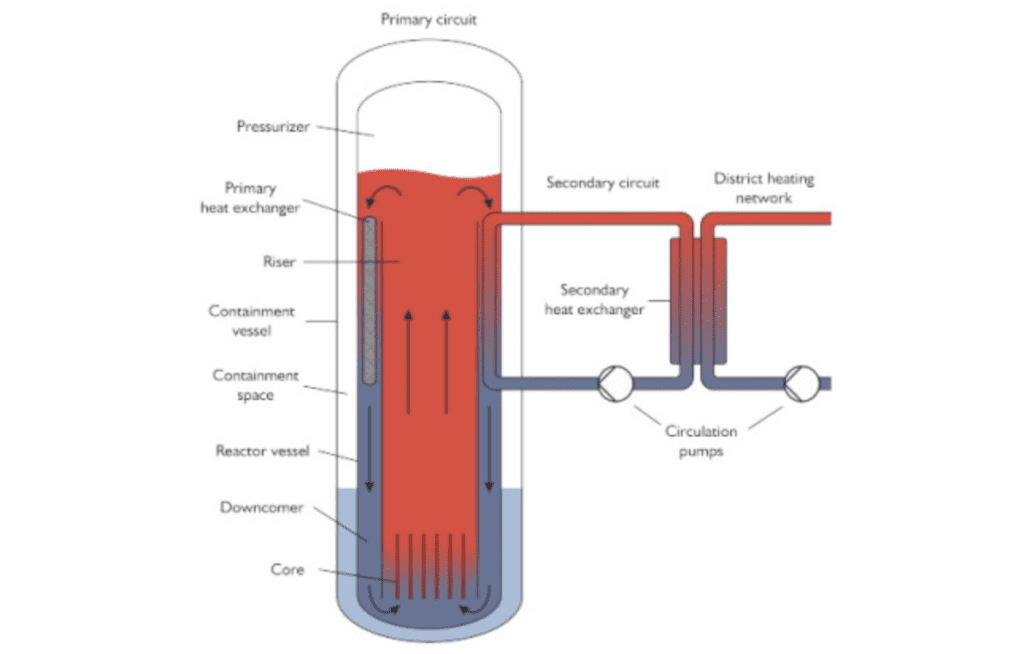Finnish Group Touts Nuclear Reactor for District Heating
A Finnish group announced construction of a reactor-based heating plant that would provide residential and district heating, saying the project would advance the district energy model and support decarbonization and electrification in Europe as more countries move away from the use of fossil fuels for energy.
Steady Energy, a company spun out of the VTT Technical Research Centre of Finland, on June 27 said its heating plant would be powered by a small nuclear reactor and produce heat at a much lower temperature and pressure than traditional reactors. The company, which announced funding from groups including VTT, Yes VC —a Silicon Valley investor in companies such as Google and Uber—and Finland’s Lifeline Ventures, said the facility would be the world’s first nuclear-powered district heating plant and would utilize VTT’s LDR-50 small modular reactor (SMR).
The company on Tuesday said it will use its initial $2.2 million of seed funding from investors for research and development of a 1:1 scale mockup that would demonstrate the functionality of an SMR-powered heating plant. The project has been part of VTT LaunchPad, a science-based spin-off incubator. VTT LaunchPad supports teams developing VTT-owned intellectual property rights into fundable spin-off companies.
In Development Since 2020
VTT began developing the LDR-50 SMR in 2020. The company said LDR-50 is a type name for a reactor with a heat output of 50 MW. The reactor is designed to operate at about 150C (302F) and below 10 bar (145 psi). The group said those operating conditions “are less demanding compared to those of traditional reactors, simplifying the technical solutions needed to meet the high safety standards of the nuclear industry.”
“The pressure required by the LDR-50 reactor is comparable to the pressure that of a household espresso machine,” said Tommi Nyman, CEO of Steady Energy. “It operates at a lower pressure than a district heating network. This ensures that in case of a malfunction which leads to a leak, the leak is contained within the heating plant, without endangering people or the environment.”
Steady Energy said that about half of all energy consumed by the residential sector in the European Union (EU) goes toward heating homes. The company said the EU’s annual district heat consumption is about 500 TWh, with about 300 TWh of that total produced by burning fossil fuels.
Nyman’s group said there are currently about 3,500 district heating networks in Europe, serving about 60 million people. It said decarbonizing residential heating across the continent represents an enormous economic opportunity, and large-scale electrification of district energy would bring a significant reduction in greenhouse gas emissions.
Nyman said, “75% of district heating systems in the EU are currently powered by fossil fuel. The situation is even worse in China. Nuclear energy is already a major source of low-carbon electricity, and small modular reactors represent a pathway to expand the use of the technology to other energy sectors in addition to heating. On top of being safer than traditional reactors, SMRs are more affordable.
“We’re setting up a demonstration plant for district heating purposes ideally in Finland, but our long-term plan is to have several plants operating around the world, producing carbon-neutral heat to homes, offices and for various industrial applications,” said Nyman. “We will bring to market the world’s best nuclear energy technology optimized for the heating sector.”
Passive Heat Removal System
Nyman said the passive heat removal system that is part of the LDR-50 reactor has a major role in its safety, noting that passive systems make it possible to meet extremely high safety requirements with simplified technology.
TYhe company said the LDR-50 reactor module features two nested pressure vessels, with their intermediate space partly filled with water. It said that when heat removal through the primary heat exchangers is compromised, water in the intermediate space begins to boil, which forms an efficient passive heat transfer route into the reactor pool. The system does not use electricity, nor does it have any mechanical moving parts, which the company said could fail and prevent the cooling function. The group said the reactor technology was awarded a patent in 2021.

“Nuclear power know-how, national energy policy and the world’s leading district heating network provide the world’s best starting point for Steady Energy to start its business specifically in Finland,” said Timo Ahopelto, founding partner at Lifeline Ventures.
Jyri Engeström, founder and partner at San Francisco, California-based Yes VC, said, “Europe and the United States have woken up to the fact that small reactors will become part of energy production already during this decade. We are talking about a very significant market globally.”
Heating and Desalination
Nyman said Steady Energy will tailor its business models according to customer needs. The group said the 50-MW size of the LDR-50 would be enough to heat a small city, noting that a single plant could have multiple reactors. The company also said a reactor-powered heating plant could be used for desalination, supporting production of fresh water. The group said its SMR-powered plants also could be modified to produce steam for industrial purposes.
“At VTT, we’ve been turning hope into action for 80 years by driving scientific innovation to change the world and businesses for the better,” said Jussi Manninen, executive vice president of VTT. “Right now, humanity is facing its most challenging adversary, climate change. We are on a journey to explore tomorrow’s technologies and innovate cutting-edge solutions to build the carbon-neutral societies of the future. Steady Energy represents our commitment to our purpose and embodies the hope we want to bring to the world.”
“To preserve our planet and ensure generations to come have a healthy planet, all combustion-based heating must come to an end,” said Nyman. “Alongside renewable energy, nuclear energy provides a steady source of energy and heat that meets the needs of modern society and helps us in our fight against climate change.”
—Darrell Proctor is a senior associate editor for POWER (@POWERmagazine).